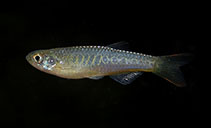| Family: |
Danionidae (Danios), subfamily: Danioninae |
| Max. size: |
2.96 cm SL (male/unsexed) |
| Environment: |
benthopelagic; freshwater |
| Distribution: |
Asia: Rakhine Yoma in south-western Myanmar. |
| Diagnosis: |
Dorsal soft rays (total): 9-9; Anal soft rays: 14-16; Vertebrae: 32-34. Distinguished from all congeners of Danio by its color pattern comprising 6-7 brown vertical bars anteriorly on side and two horizontal rows of small brown spots posteriorly, absence of D stripe, and absence of dark stripes on caudal fin. This species is similar to Danio kerri and Danio erythromicron in having 12 circumpeduncular scale rows (vs. 14 in Danio dangila and 10 in other species of Danio); and in having 6 branched dorsal fin rays (vs. 7-8 in other species of Danio) (Ref. 81818).
Description: Dorsal fin ii.6½ ; anal fin iii.10½, iii.11½, iii.12½; pectoral fin i.10, i.11; and pelvic fin i.7. Lateral scale rows between dorsal and pelvic fins 7. (Ref. 81818).. |
| Biology: |
The type locality is a small stream flowing out of the forest into cultivations, at most 3 m wide and about 30 cm deep. This small stream is characterized by clear water and only slight current, bottom comprising pebbles rock, and gravel, and by the absence of aquatic vegetation. Also occurs in a stagnant pool with leaf litter and sandy bottom and in small forest streams with rocky bottom (Ref. 81818). |
| IUCN Red List Status: |
Near Threatened (NT); Date assessed: 26 May 2010 Ref. (130435)
|
| Threat to humans: |
harmless |
Source and more info: www.fishbase.org. For personal, classroom, and other internal use only. Not for publication.

